Historical Giving: 1883 - 1995
- William Gibson (1883)
- White Memorial (1922)
- Maloney (1929)
- Dulles Agnew (1941)
- Gates Memorial (1953)
- Donner (1958)
- Ravdin Institute (1963)
- Ravdin Courtyard (1973)
- Silverstein (1978)
- Founders Pavilion (1987)
- Rhoads Building (1995)
William Gibson (1883)
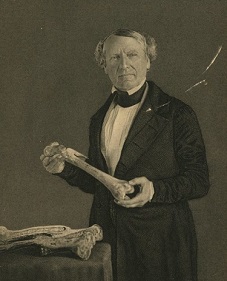 Backstory
Backstory
In 1872, after over a century of being located in downtown Philadelphia, The University of Pennsylvania's campus moved across the Schuylkill River to West Philadelphia. The university purchased this property from the Blockley Almshouse – a charitable hospital and poorhouse. Additionally, the city agreed to sell 6.892 acres to the Trustees for $500 and donated 50 free hospital beds for the City's poor.
On June 4, 1872 the Provost presented copies of this ordinance to the Trustees, who authorized the purchase of the land. Original deed to HUP (see footnote).
Thirteen hospital buildings now occupy this land: Gates Memorial (1953), Centrex Building (1969), Founders Pavilion (1987), rear of Gibson Wing (1883), Maloney (1929), Rhoads (1995), Donner (1958), Devon MRI Center (1986), Silverstein (1978), Ravdin Institute (1963), Ravdin Courtyard (1973), White Memorial (1922), and Dulles-Agnew (1941).
Footnotes
With the exception of the rear of the Gibson Wing, none of the above buildings were original to the site. Gates replaced the Spruce Street front of Gibson and the original Central Hospital (1874). The Centrex building replaced the Dispensary. Founders replaced the rear of the Central Hospital. Maloney replaced Pepper Laboratory of Clinical Medicine. Rhoads replaced the Maternity Wing. Donner and Devon replaced the Isolation Ward, the Mortuary, and the Laundry. Ravdin and Silverstein replaced the Nursing Home.
(https://www.archives.upenn.edu/primdocs/uph/uph500/deed1872hup.pdf)
White Memorial (1922)
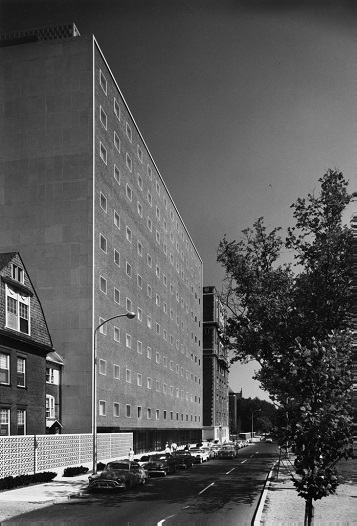 Bullet Points
Bullet Points
- Second building on campus named after J. William White (the other is the 'training house' in the sports complex)
- Architect: Arthur H. Brockie and Theodore M. Hastings
Maloney (1929)
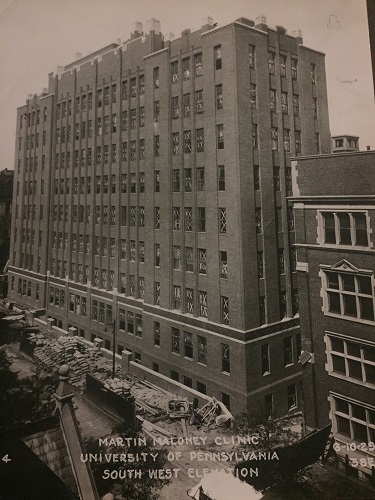 Bullet Points
Bullet Points
- Martin Maloney was an Irish immigrant who made his fortune on the electrification of the city.
- Penn’s only Art Deco structure
- Martin Maloney donated $250,000 to this $1 million capital project
- Architects: Marmaduke Tilden, H. Bartol Register, and George W. Pepper
Backstory
On September 13, 1928 the University of Pennsylvania broke ground on the Martin Maloney Memorial Clinic, occupying the site of the old Pepper Laboratory of Clinical Medicine. This capital project cost slightly more than $1,000,000 and was the first unit in the eventual modernization and expansion of the University Hospital. By design the Martin Maloney Memorial Clinic focused on a number of house dispensaries for medical and allied groups, a Hyrdo-therapy and Physio-therapy department, and small sized wards for special cases requiring particular study and care.
It also took advantage of the immediate proximity to the wards and dedicated a group of highly trained professionals to handle the most difficult problems. It was the third building added to the medical campus that year, accompanied by the opening of a new $2,000,000 teaching hospital of the Graduate School of Medicine, and the new $1,000,000 Laboratory of Anatomy and Biochemistry.
The clinic was funded largely through the generosity of Mr. Martin Maloney, of Spring Lake, NJ, who gave Penn $250,000. Maloney was born in Country Tipperary, Ireland on Nov. 11, 1848. In 1854, to escape the potato famine, his family immigrated to America and settled in Scranton, Pennsylvania. To help support the family, as a young teen, Maloney worked in the coal mines, later as a tinsmith, copper smith, plumber and gas fitter.
Eventually, Maloney founded The Pennsylvania Globe Gas Light Company, which supplied the patented naphtha gas lighting system for street lamps. This invention created an immense fortune in royalties which only increased after the United Gas Improvement Company - which furnished the water, electric and gas for many public city utilities - started using Maloney's patent.
Footnotes
Dulles Agnew (1941)
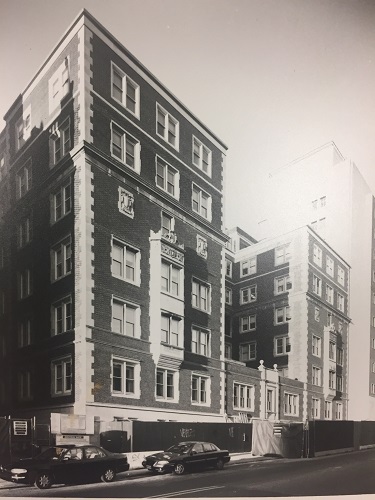 Bullet Points
Bullet Points
- Named for two people: 1.) Dr. D. Hayes Agnew, a celebrated surgeon who brought asepsis to Penn’s operating theater. 2.) William Crothers Dulles, who graduated from Penn Law and died on the Titanic in 1912.
- Mrs. Andrew C. Dulles (mother) and Baroness Margaret Dulles Fontana (sister) donated 750,000 in honor of William Crothers Dulles. The mother was very close to her son and went hysterical after learning of the Titanic especially because she was the very reason he was traveling.
- Architects: Marmaduke Tilden, H. Bartol Register, and George W. Pepper
Backstory
The Crothers Dulles Cancer Hospital was the generous estate gift of Mrs. Mary B.C. Crothers Dulles, the widow of Andrew Cheeves Dulles. The donation was made in memory of her son, William Crothers Dulles, who died on the Titanic.
Mrs. Dulles, who died April 7, 1931 at the Barclay, asked for her entire estate of $232,000 [n.b., that's ~$3,824,123.16 in 2018 dollars] be held in a trust for this purpose. The only condition was that her only living child, the Baroness Ettore Romano Fontana, formerly Margaret Dulles, was to have the estate income during the remainder of her life.
The will stated that upon her death the trustees were to erect "a building of brick and limestone to be used for a hospital for the treatment of cancer or other such diseases as the board of trustees shall deem advisable." They were able to accept or reject her bequest before or after the daughter's death. If they did not accept it, the estate was to revert to the Pennsylvania Hospital for the same purpose, and should this hospital reject it as well, then Jefferson was to receive the funds.
Footnotes
Gates Memorial (1953)
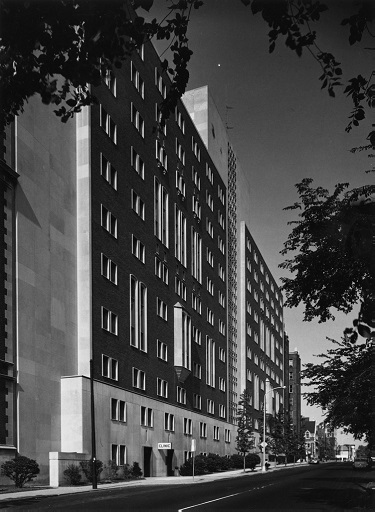 Bullet Points:
Bullet Points:
- Named after Thomas Sovereign Gates (1873-1948), a financier who served as President of the University and later as chairman of its Board of Trustees
- Gates is accredited with having the vision for the transformation of the hospital into the medical center it has become
- Architects: Schmidt, Garden, and Erikson
Backstory
Thomas Gates was a well-respected Penn alumnus, Philadelphian, and Trustee of the University for almost ten years. The University benefited from Gates' knowledge and dedication during 1930s and early 1940s as the nation experienced some of its toughest times in history.
Gates tenure was notable for establishing the College for Women in 1933 and the School of Nursing in 1944. Gates also attempted to develop a Valley Forge campus with hopes that a "smaller, more secluded environment would facilitate discussion and interaction among students and faculty members."
Although the Valley Forge campus failed, Gates did successfully convince the University to purchase what is now known as the Morris Arboretum. Gates reasoning: "With its wealth of trees, open stretches of lawn and meadow, plantings of non-shrubby character, winding brooks, grotto-greenhouses and excellent examples of ceramic art and statuary, the arboretum offers a variety of attractions, both to the layman and the scientist."
Footnotes
https://www.archives.upenn.edu/histy/features/uplans/gates.html
Donner (1958)
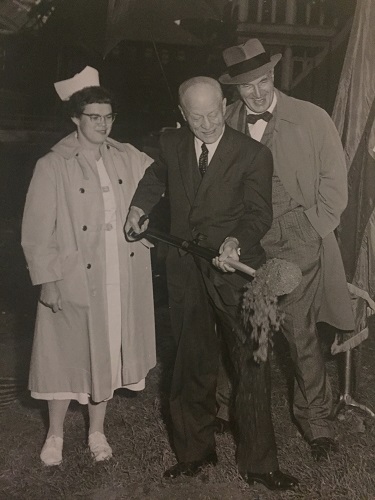 Bullet Points
Bullet Points
- Named after William Henry Donner a Pennsylvania steel manufacturer
- William Donner lost one son to cancer (1929) and another son to heart disease (1931)
- Most widely known for establishing the International Cancer Research Foundation in June 1932 with an investment of $2,000,000.00
- By recommendation of Thomas Gates, Donner purchased a giant atom smasher, also known as a cyclotron for the Department of Radiology. It cost $200,000.00
- The Donner Diagnostic Clinic in the Thomas Gates Pavilion was initiated with an original $1 million pledge from Mr. Donner
Backstory
William Henry Donner (1864–1953) was an American businessman and philanthropist, born in Columbus, Indiana. Early in adulthood, he managed the family-owned grain mill and later invested in natural gas and real estate. He also founded the National Tin Plate Company and the Union Steel Company.
He was actively involved in establishing the new community of Donora, PA. In 1948, this town became infamous for the "Donora Smog of 1948" - a historic air inversion resulting in a wall of hydrogen fluoride and sulfur dioxide smog that killed 20 and sickened 7,000. The fire chief at the time reported he depleted the town's supply of 800 cubic feet of oxygen but proudly claimed he himself didn’t take any.
No stranger to untimely deaths, Donner lost one son to cancer (1929) and another to heart disease (1931), after which he devoted his fortune to advancing scientific research and medical care. He is most widely known for establishing the International Cancer Research Foundation in June 1932 with an investment of $2 million. By recommendation of Thomas Sovereign Gates, Donner purchased a cyclotron for Penn's department of radiology for $200,000. The Donner Diagnostic Clinic in the Gates Pavilion was initiated with a $1 million pledge from Donner. In addition, Donner donated $2.5 million to endow chairs at prominent universities across the East Coast. Per the MIT newspaper at the time: "The Donner Chairs will be the most highly endowed chairs ever established at the University of Pennsylvania and Massachusetts Institute of Technology, and among the most highly endowed at Harvard, Yale and Princeton."
The Donner Canadian Foundation was established in 1950 and ran as a typical Canadian charitable fund until1993 when the conservative American Donner heirs changed the foundation's primary focus to supporting conservation research. From 1993 to 1999 the foundation provided the seed money to start several conservative Canadian think-tanks and publications and became the 'lifeblood of conservative research' in Canada. In 1999, these same American heirs began donating more money to land and wildlife conservation, international development, medical research, and the arts.
Footnotes
Ravdin Institute (1963)
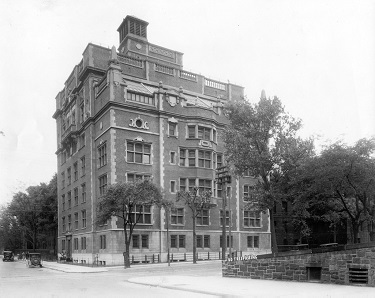 Bullet Points
Bullet Points
- Named after Dr. I. S. Ravdin (1912-1972)
- Dr. Ravdin was the fourth generation of Ravdin family physicians
- Surgeon in Chief of the Hospital of the University of Pennsylvania
- A John Rea Barton Professor of Surgery; Director of the Harrison Department of Surgical Research in the School of Medicine
- Especially noted for his work on the liver and the biliary tract, for his investigations on nutrition in relation to wound healing, and for his studies of plasma substitutes
- During WWII commanded the 20th General Hospital in the China-India-Burma theater
- Recipient of the Legion Merit, 1944 & Oak Leaf Cluster, 1950
- Trustee and benefactor to the Philadelphia Museum of Art (PMA) and the Rosenbach Foundation
- $1 million minimum starting goal; finished as a $7.7 million patient-care and research building
- Built by the gifts and grants of nearly 4500 individual benefactors, foundations, corporations, and public agencies
- Architects: Schmidt, Garden and Erikson
Backstory
Dr. Ravdin, born in Evansville, Indiana, became a Penn medical student in 1918. After earning his medical degree, he rose to become the first chair of the Harrison Department of Surgical Research and later the chair of the Department of Surgery. During World War II, Dr. Ravdin served as the chief administrator of the 20th General Hospital in Assam, India and eventually became the major general.
Dr. Ravdin was part of the team who performed a bypass procedure on President Dwight Eisenhower.
Interestingly, Dr. Ravdin was often featured in the comics. One famous comic strip features a woman who faints at a party and is brought to the 'University Hospital' where the unnamed doctor, referred to as 'The Man' by his staff, takes charge of her care. Using not his surgical skills but his medical training and psychological insights, 'The Man' makes a diagnosis. What may surprise readers of a later generation is that the doctor is shown many times smoking a cigarette, even while walking down the hospital hall or in the patient’s room.
Footnotes
- Original image of HUP: http://dla.library.upenn.edu/dla/archives/image.html?q=hospital&start=25&id=ARCHIVES_20011001002&
- http://dla.library.upenn.edu/dla/archives/detail.html?id=ARCHIVES_20040712001
- Anesthesiologist at HUP circa 1950: http://dla.library.upenn.edu/dla/archives/image.html?q=hospital&start=75&id=ARCHIVES_20080813010&
- 'The Man' comic strip: https://www.pennmedicine.org/news/publications-and-special-projects/penn-medicine-magazine/archived-issues/2015/summer-2015/ravdin
Ravdin Courtyard (1973)
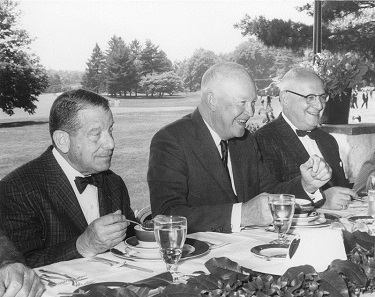
Silverstein (1978)
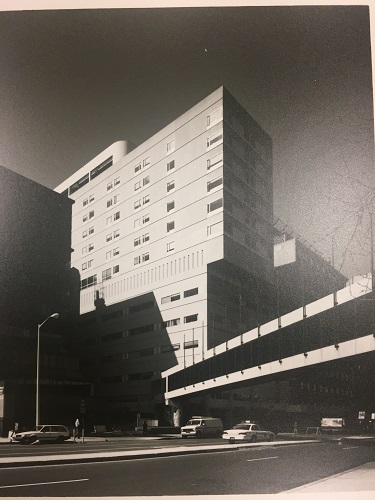 Bullet Points:
Bullet Points:
- Louis Silverstein was an industrialist and philanthropist
- Silverstein spearheaded the fundraiser behind the Ravdin institute, personally making the largest individual donation in Penn’s 233-year history. In gratitude, the University named the Silverstein Pavilion
- Fun Fact: the foot bridge was originally designed to connect to a hotel which later became the bed towers, and which will soon be the Pavilion.
- Architects: Geddes, Brecher, Qualls and Cunningham
Founders Pavilion (1987)
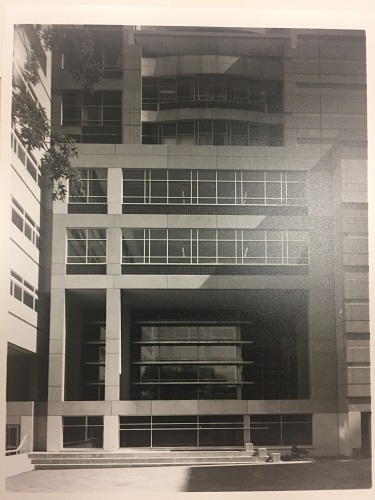 Bullet Points
Bullet Points
- As stated in the University of Pennsylvania Almanac, September 29, 1987: “…christened to honor those at Penn who introduced medical education to the Colonies in 1765"
- Founders Pavilion is a 14-story tower with 124 medical and psychiatric beds, 88 intensive care beds, and 23operating suites plus a 375 seat cafeteria
- Boasting state-of-the-art designs: placing the surgical, intensive care unit on a circular plane so that all rooms were visible from any vantage point
- $96 million dollar capital project
- Architects: Geddes Recher, Qualls Cunningham, Alan Fishman, principal–in–charge
Rhoads Building (1995)
Bullet Points
- Named after Jonathan Evans Rhoads (1907-2002)
- Dr. Rhoads was Head of the Penn Medical School Department of Surgery, WW II and 1959-1972
- Professor of Surgery and Surgical Research, 1944-1972
- Provost of the University, 1956-1959
- A John Rhea Barton Professor of Surgery
- The esteemed mentee of I. S. Ravdin
- The number of financial commitments made to secure the building's name is unknown
- Architects: Robert D. Lynn, Associates [design architect] Payette Associates [laboratory designers]


